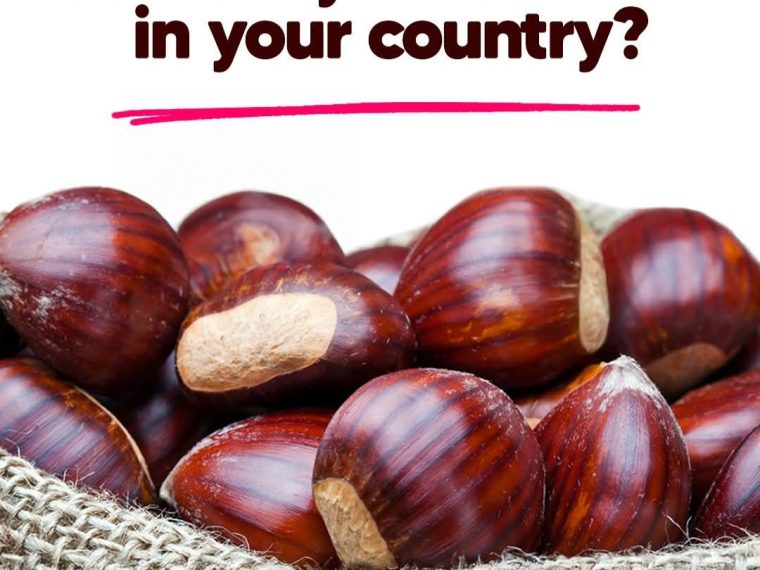🌰 Sweet Chestnut (Edible Chestnut)
🔹 Scientific Name:
Castanea sativa
🔹 Family:
Fagaceae, the same family as oak and beech trees.
🔹 Origin and Habitat:
The sweet chestnut is native to Southern Europe and Asia Minor and is widely grown across Europe, North Africa, and parts of Asia. It thrives in temperate climates, especially in hilly and mountainous regions with well-drained, slightly acidic soil.
🍃 Description:
The sweet chestnut tree is a large, long-lived deciduous tree that can reach up to 35 meters (115 ft) in height.
- The leaves are long, serrated, and glossy green.
- In summer, it produces catkins (long yellowish flowers).
- In autumn, the tree bears spiky green burrs that split open when ripe to reveal 1–3 shiny brown nuts inside.
🌰 The Fruit:
The chestnut itself is wrapped in a thin, brown shell and an inner skin (pellicle) that must be removed before eating.
- The flesh is slightly sweet, starchy, and nutty.
- Unlike most nuts, chestnuts are low in fat and high in carbohydrates, making them more like a grain nutritionally.
💪 Nutritional Benefits:
Sweet chestnuts are highly nutritious and energy-boosting:
- Rich in: vitamin C, B vitamins, potassium, magnesium, iron, and fiber
- Low in: fat and calories compared to other nuts
- Gluten-free, making them suitable for people with celiac disease
- Contain antioxidants that help fight inflammation and support heart health
🍴 Culinary Uses:
Chestnuts are incredibly versatile in cooking:
- Roasted over a fire (a classic winter snack)
- Boiled or steamed and served with butter or honey
- Ground into flour for gluten-free baking (bread, cakes, pancakes)
- Used in soups, stuffing, purees, and desserts (like Mont Blanc or chestnut cream)
🌳 Other Uses:
- The wood of the chestnut tree is valued for furniture, fencing, and barrels due to its strength and durability.
- In traditional medicine, chestnut leaves and bark have been used for respiratory relief and circulation support.
⚠️ Important Note:
Don’t confuse sweet chestnuts with horse chestnuts (Aesculus hippocastanum) — the latter are toxic and not edible. Always check for:
- Spiky burr (many needles) = edible sweet chestnut
- Smooth, less spiny capsule = toxic horse chestnut
Would you like me to turn this into a formatted article for your website (with intro, subheadings, and SEO keywords like health benefits of sweet chestnuts, how to roast chestnuts, etc.)?
The only edible “chestnut” is the sweet chestnut, which is the fruit of the chestnut tree (Castanea sativa). It should not be confused with the horse chestnut, which comes from the horse chestnut tree (Aesculus hippocastanum). The latter is toxic and must never be eaten.
You can tell the two fruits apart by their appearance:
- The sweet chestnut usually comes in groups of several within a spiky burr and has a flatter shape.
- The horse chestnut, on the other hand, has a smooth shell and a rounder, often single fruit inside a less spiny capsule.
🌰 Sweet Chestnut (Edible Chestnut)
Plant: Chestnut tree (Castanea sativa)
Appearance: Irregularly shaped fruits, often found in groups of 2 or 3 inside a spiny burr.
Uses: Can be eaten raw (certain varieties have a hazelnut-like flavor) or cooked (roasted, boiled, or made into purée).
Where to find it: Mainly in forests or orchards.
❌ Horse Chestnut
Plant: Horse chestnut tree (Aesculus hippocastanum)
Appearance: Rounder, smoother, and often larger than the sweet chestnut, usually found alone in its capsule.
Uses: Not edible and toxic due to the presence of saponins; can cause digestive problems such as nausea and vomiting if ingested.
Where to find it: Commonly found in urban areas, such as parks, public squares, and schoolyards.





